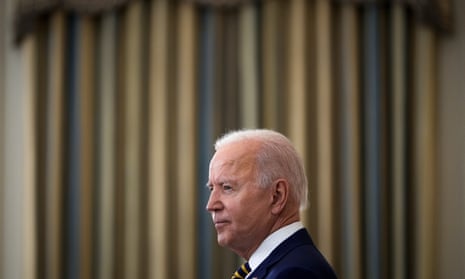US deaths from Covid-19 have dipped below 300 a day for the first time since March last year during the first wave of the pandemic.
Data from federal sources also showed the drive to put shots in arms at home approaching an encouraging milestone: 150 million Americans fully vaccinated.
Joe Biden was however expected to fall short of his commitment to shipping 80m Covid-19 vaccine doses abroad by the end of June, because of regulatory and other hurdles.
Jen Psaki, the White House press secretary, told reporters getting the shots shipped was proving to be “a Herculean logistical challenge” – which the administration has been unable to meet.
The US death toll from Covid-19 stands at more than 601,000. The worldwide count is close to 3.9m. The real figures in both cases are believed to be markedly higher.
About 45% of the US population has been fully vaccinated, according to the federal Centers for Disease Control and Prevention. More than 53% of Americans have received at least one dose, the CDC also said on Monday.
New cases are at about 11,400 a day, down from more than 250,000 in early January during the most recent US surge of coronavirus. US deaths per day are down to 293, according to Johns Hopkins University, after topping out at more than 3,400 in mid-January.
The coronavirus was the third-leading cause of death in the US in 2020, behind heart disease and cancer, according to the CDC. Now CDC data suggests more Americans are dying every day from accidents, chronic lower respiratory diseases, strokes or Alzheimer’s disease than from Covid-19.
In New York, Governor Andrew Cuomo said on Monday the state had 10 new deaths. At the height of the outbreak there, in spring 2020, nearly 800 a day were dying.
In Washington, the White House announced the final allocations for the vaccine doses for export, with 60m shots going to the global Covax vaccine-sharing alliance and 20m directed to specific partners.
But fewer than 10m doses have been shipped so far, including 2.5m delivered to Taiwan over the weekend and about 1m to Mexico, Canada and South Korea earlier this month.
At a briefing, Psaki, said: “What we have found to be the biggest challenge is not actually the supply, we have plenty of doses to share with the world, but this is a Herculean logistical challenge.”
On 17 May, Biden announced that “over the next six weeks, the United States of America will send 80m doses overseas”, adding: “This will be more vaccines than any country has actually shared to date – five times more than any other country – more than Russia and China, which have donated 15m doses.”
Earlier this month, he announced that on top of the 80m, the US was purchasing 500m doses from Pfizer to donate globally, with first deliveries expected in August.
Biden committed to providing other nations with all 60m US-produced doses of the AstraZeneca vaccine, which is not approved for use in the US. The doses have been held up by a safety review by the Food and Drug Administration.
Biden was expected to be able to meet the 80m commitment without AstraZeneca. The White House unveiled plans earlier this month for the first 25m doses for export from stockpiles of Pfizer, Moderna and Johnson & Johnson vaccines. Some have begun shipping.
Through Covax, the latest batch of doses will include about 14m for Latin America and the Caribbean; approximately 16m for Asia; and about 10m for Africa. About 14m doses will be shared directly with other countries.
Meanwhile, US demand for shots has slumped.
Ana Diez Roux, dean of Drexel University’s school of public health, said the dropping rates of infections and deaths are cause for celebration.
But she cautioned that the virus still has a chance to spread and mutate given the low vaccination rates in some states, including Mississippi, Louisiana, Alabama, Wyoming and Idaho.
“So far it looks like the vaccines we have are effective against the variants that are circulating,” Diez Roux said. “But the more time the virus is jumping from person to person, the more time there is for variants to develop, and some of those could be more dangerous.”
